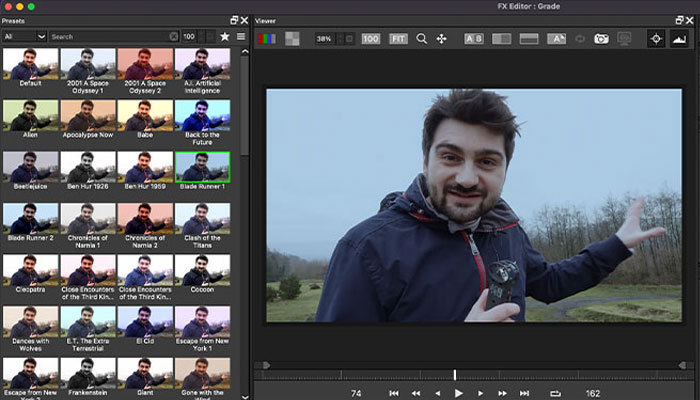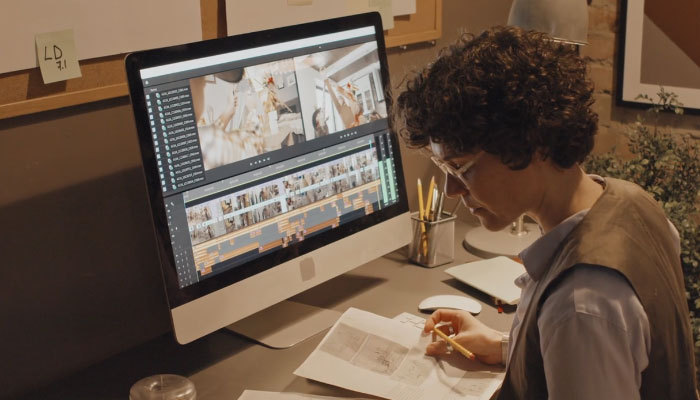Today on Art of the Cut, we talk with the editors of Black Adam: John Lee and Mike Sale, ACE.
Michael's credits include Red Notice, Central Intelligence, We're The Millers, The Hangover II, and Bridesmaids (for which he was nominated for an ACE Eddie).
John started his career as an assistant on the original Matrix movie. He was an additional editor on Inception and an associate editor on movies like Tenet, X-Men: Dark Phoenix, Dunkirk, Spectre, and Interstellar.
SALE: Thank you for having us. I really wanted to do this after Red Notice, and Julian did, too. But I went from finishing a final mix where you hug the director in the parking lot, and then I had one day off — a Sunday — and then Monday, I went into Black Adam. It was in the middle of the director’s cut. John was a machine, and he was going full force. And I didn’t have time to do a single thing, including your podcast. So thank you for having us — a year late, but…
Mike Sale and John Lee Discuss the Editing of Black Adam
I'm really glad to have both of your expertise. I'm really excited to talk about this film. I think there's a lot of stuff to talk about.
There's a scene early on where they're discovering the cave where Black Adam is entombed. I was thinking how much that scene could have “accordioned.” You could have stretched it out and increased the tension, or you could have collapsed it and made them get there quicker. How much of that scene was sculpted? Did it compress and expand?
LEE: We had a great pre-viz editor who was in Atlanta. So when I was on the film getting the dailies (at Warner Brothers), and it was just my assistant and me, and because it was the pandemic, we had visual effects, people working at home and some assistants working at home. But Krisztian Majdik was over in Atlanta, and that was a scene that was pre-viz. It was quite large. It had a lot of things in it. And the dailies came in. The first thing was to just build that scene kind of like it was pre-viz. But then there was extra stuff as well. So he did a great job with that.
And I do remember the first time I showed (director) Jaume (Collet-Serra) that scene. He was in Atlanta. I had never met him. I'd only met him on Zoom. I used to cut something and then show him on ClearView and have a Zoom session at the end of the day when they were all exhausted, and he would be in a room with people. So he had a black mask on and a black hat and has this Spanish accent. And I would play something on Clearview, and then I would look. And he would kind of shrug, say, “Yes.” And I'd think, “Did he like it, or what happened?” So I would have to call Krisztian afterward and ask, “Did he like that, or did he not like that?” Krisztian would say, “No. He liked that. That was fine.”
Other times, Jaume would just tell me — because, you know, when you're working with a new director, you don't know what they like, and I think when I first started, I was cutting quite conservatively, and then he would say, “No, I've got these high angles, or these other angles cut to that, cut to that.” And then I would have another turn and show him, and then you know what he likes after a while.
And the other funny thing about that sequence, the first time I cut it and showed him I didn't have any music in it because that just seemed like not cutting with music is kind of a good thing. Like if it works without music, it's going to work. That's kind of my theory. He was horrified and said, “What are you doing? I need music in it.” I went back. I put music in it, and I recut it. That's the way we worked from then on.
But, when Mike came on — I started in April, I think — and Mike was on another film, and he'd been looking at the dailies. But when Mike came on, I remember one of the first things he did was he got that scene, and he — I'm not going to say “butchered” it.
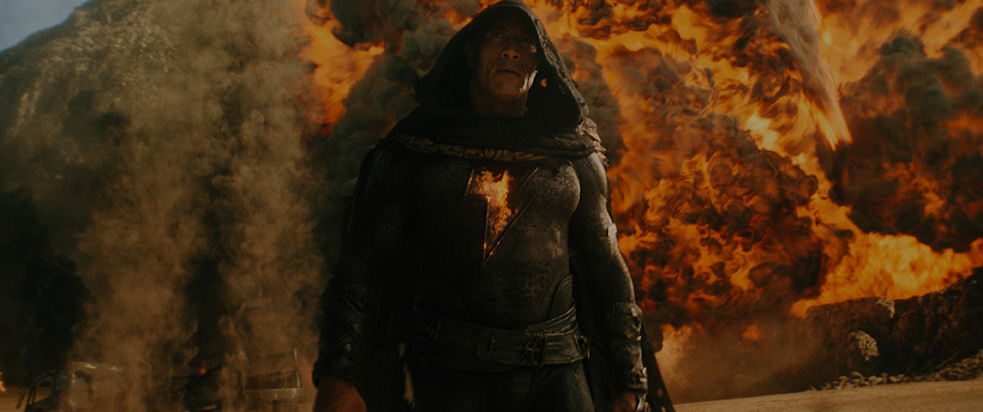 DWAYNE JOHNSON as Black Adam in New Line Cinema’s action adventure “BLACK ADAM,” a Warner Bros. Pictures release.
DWAYNE JOHNSON as Black Adam in New Line Cinema’s action adventure “BLACK ADAM,” a Warner Bros. Pictures release.
I'm sure he's grateful for that!
LEE: He tore into it. When you’re starting, you have everything in.
Right. Right.
LEE: Mike just looked at it and went, oh, we could lose some things here. And he did this amazing version that just cut a lot of stuff out.
SALE: It was interesting because John was assembling and cutting while I was off on Red Notice. I'm coming home at night and watching dailies. There was a LOT of footage. They would have seven cameras going, not with the intent that we would use all seven cameras, but they could do it. There was a lot of blue screen and whatnot, so it doesn't matter if there's a crew in the shot or anything. So they just did the smart thing: “Hey, here are our real cameras, but we're also going to put one here, here, here, here.”
I talked to John early on. He said, “Do you think we got enough coverage?” “Yes. Yeah. Yeah, you do.” There's more than I can comprehend. I was coming off a film where I was in the mode of “Every frame counts. We’re at the final mix. We're releasing a movie. Here we go.” And I walk in during an early director's cut where you gotta cut things in before you cut them out, right?
Essentially what you're talking about is reel one. If you think about it — instead of just little scenes from the beginning of the film to Black Adam passed out in the desert — is basically reel one. The trick with any movie in reel one is balancing exposition with action or humor or whatever to sort of pull the audience through and yet entertain them because you have to get the exposition out there and set up the world. One of the things on Black Adam is there was a lot of exposition.
It's a massive movie with a lot of characters. Not only that, you have a 5000-year-old character who has a full backstory, and then you have the JSA (Justice Society) characters. John knows a lot more about the comic books and stuff than me. But as soon as you start to peel away the layers of, say, Hawkman, there are 50 years of exposition about Hawkman. How do you get that into one movie that has eight other characters?
So with reel one, it's about the balance of that pace and how many things you're saying. We do like character depth and all that stuff, but initially, there's so much of a laundry list of things that you can't actually follow. So what you're seeing in the final movie is we finally sort of came upon the idea that it’s just about the crown.
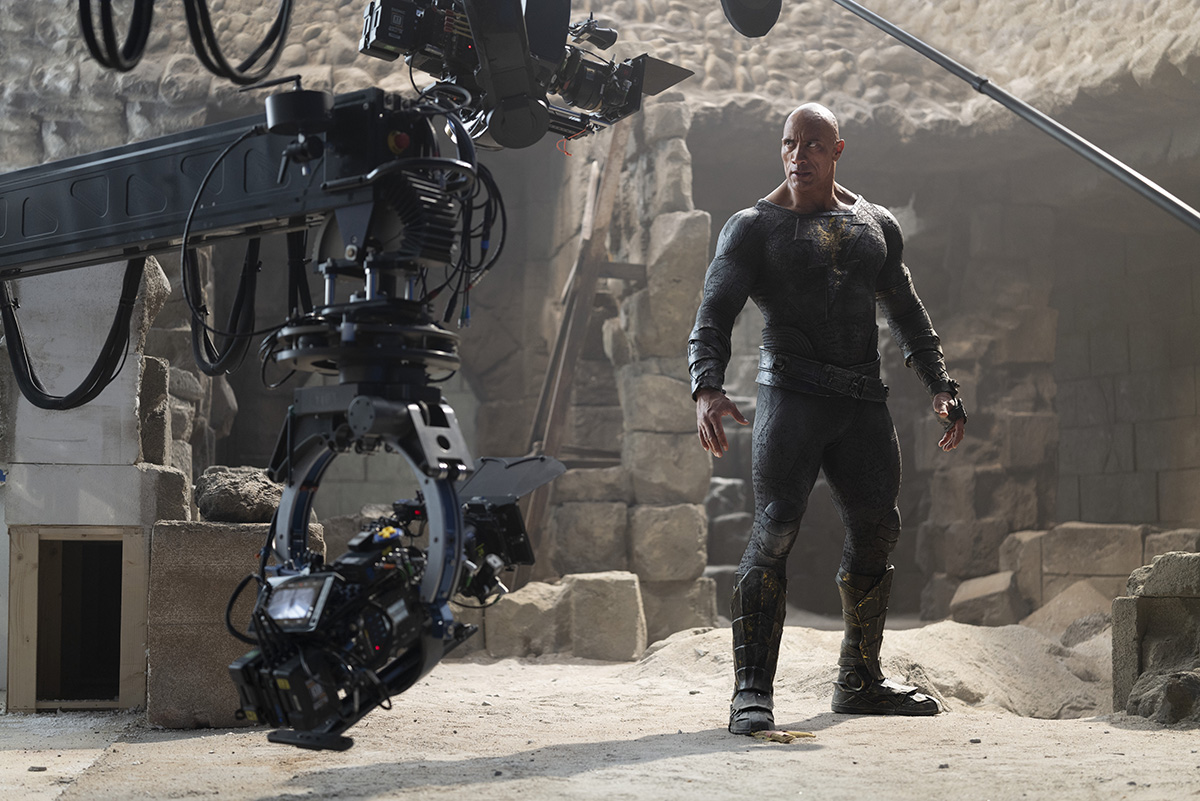 DWAYNE JOHNSON on the set of New Line Cinema’s action adventure “BLACK ADAM,” a Warner Bros. Pictures release.
DWAYNE JOHNSON on the set of New Line Cinema’s action adventure “BLACK ADAM,” a Warner Bros. Pictures release.
The crown is kind of the McGuffin of this movie.
SALE: Now, the beginning of the movie starts with the crown. They're in the van. They're mostly talking about the crown.
LEE: There were a few scenes there that were trimmed, or we lost. Scenes started very long and very involved. And then — like Mike says — it got cut down to its essence.
SALE: Once Black Adam wakes up there was actually very little removal there. There might have been a joke that wasn't necessary or something that had come out of there. But that was a couple of weeks into the director's cut.
When I first got there, they showed me five reels of the film. Reel six was still kind of being created. It was overwhelming. There was so much stuff. There were so many visual effects shots. There was so much information and exposition and things in the film, but it was also already awesome. If we survive this.
LEE: Yes.
 (L-R) Editor John Lee; Lee and editor Mike Sale
(L-R) Editor John Lee; Lee and editor Mike Sale
If we survive it!
LEE: Yeah, a lot of footage. I came up with systems where I made little reels of the print takes to be able to cut something in a day. Because if you looked at all the dailies, your day would be over, and you hadn't even done anything. So I used to make just the print take rolls. I would always go back and look at the other stuff, but I'd make these print take rolls and I'd make little stacks or string outs or whatever, which I would use later, but it was just a way to manage it. And there was a time where I called New Line and said, “Is there any way Mike can come on early?” We managed to keep up to camera, but it's just a lot of footage. We were drowning and Krisztian was great because a lot of these action sequences — the one in the cave was good, the fly bike chase in reel three was a movie in itself. The previs of that had jokes in it. It had whole weird backstories with Black Adam and the intergang soldiers. It was great, but it was like 20 minutes long.
We built that with everything and then that's one that got trimmed and changed quite a lot. The one in the cave stayed pretty much how it was.
Once the gun battle begins, there's a lot of fast motion and slow motion stuff. Obviously, it's all VFX, but how much of that had to be sculpted in editorial by you to determine when things are fast and when things are slow and the pacing of all that?
SALE: You're talking about the oner. There's kind of a big oner when Black Adam starts flying around, right? All the timing of that was done in editorial. So all the speed up and slo mo and all those things were done there basically creating a template for visual effects. And then once they started making it. It was tweaked many, many, many times. I won't say hundreds, but I'll say dozens of meetings for that shot.
LEE: Right. Yeah.
SALE: Going over that shot. A lot of the stuff was what happens in the background and when is there lightning? And trying to get the timing right, then coordinating that with sound. At first when it's very rough, they're just putting sound on what's on the screen. Then we have to say, “No, no! He's killing 30 guys that you DON’T see!” We're going in and putting our assistants screaming and stuff in the background and we're trying to create the timing that everybody else can follow.
LEE: They also shot those scenes at different frame rates. Jaume knew that he was going to be messing with the speed ramps and things, so he wouldn't shoot it at 24.
Of course.
LEE: He would shoot at 96fps or 48 or whatever for specific shots. In fact, a lot of the dailies in the action, they shot at 96 or 48 or something like that. And then we would have the assistants or Company Three make us 24 frame versions. And so sometimes we would cut with the 24 frame version because it had the sound and everything. But then when it was a bit where we're going to do some monkey business with the speed ramps and things, we would cut the other one in and that's what we would use.
SALE: And then in some of the other sequences it was like a thousand frames a second, right?
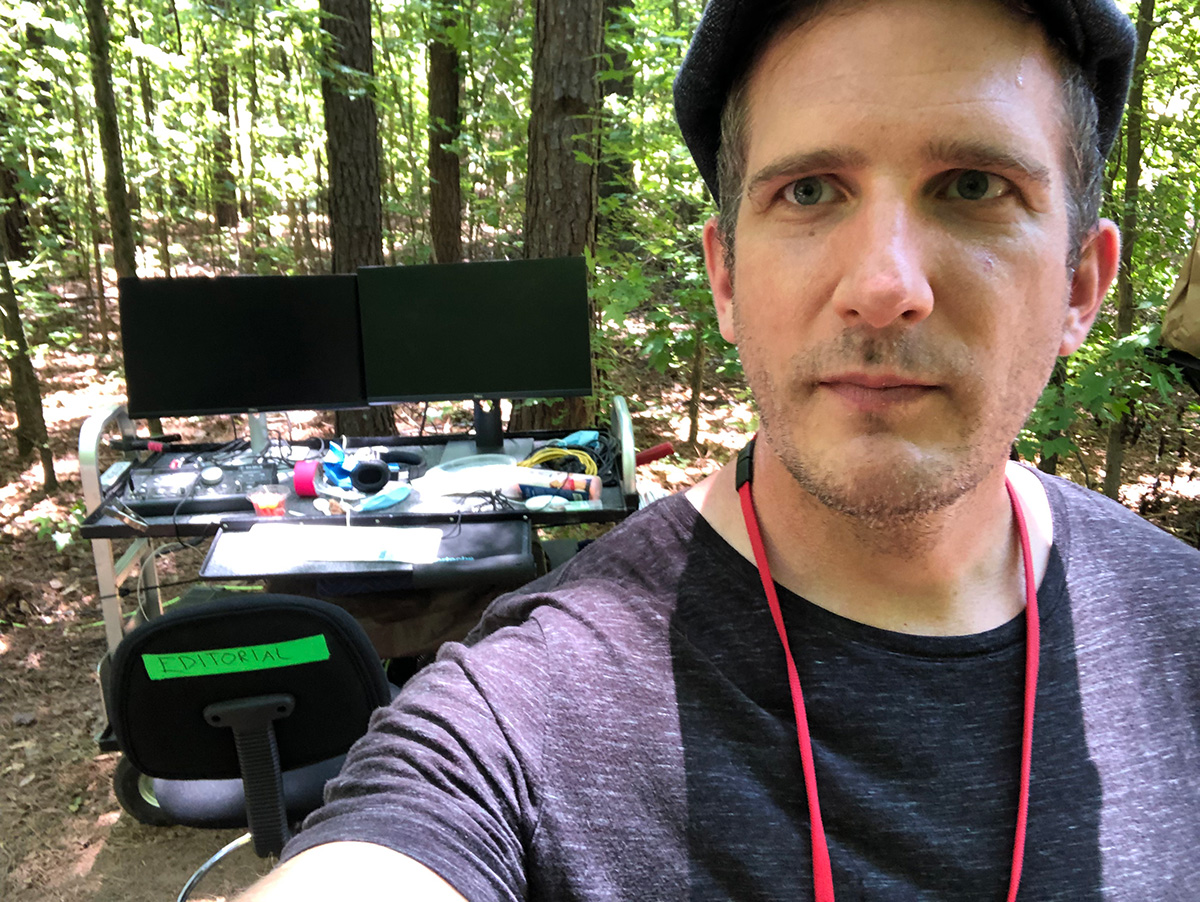 VFX Editor and Additional Editor, Krisztian Majdik on set
VFX Editor and Additional Editor, Krisztian Majdik on set
It's interesting because it seems like a oner and it seems like all VFX, but I figured it was kind of like animation editing almost, where the timing still has to come from you guys.
SALE: John's mentioned Krisztian, who is a visual effects editor, but then we also brought him on as an additional editor on the movie. This was the first time where I worked on a film where the people doing the pre-visualizations stayed with us through the movie and it was really smart and really cool. When we're talking about manipulating the time on those things, we're doing that to drawings, we're doing that to cartoons, basically. It kind of looks like a video game. A lot of times what happens is that these people at previs companies — like The Third Floor — they work with the director for a long time, like three months, six months. In this case, it was over a year because of the pandemic. They got to work on all the actiony previsualization sequences for a lot longer than normal. So they were awesome, but huge! Way bigger than anybody could ever afford.
Carrying Krisztian with us was great because normally we're disconnected from that world. We don't know what the thought was. We don't know what the thinking was. We don't know how things evolved or why they're in there. Sometimes it's almost like you're an archaeologist. You're looking at a little frame and you're wondering, “Well, why did they cut to this angle? What is this in the movie for?” Then you talk to someone and they can explain, “See that little thing in his hand? That's a feather that has meaning.”
So when it's disconnected you don't really know, but with Krisztian, it was like a time machine. We could go back for a whole year and he could explain, “No, it's supposed to feel like this. Supposed to feel like that.”
LEE: The other thing about Krisztian is that when the pandemic hit, they were about to shoot, and they shut down for a year, but Krisztian stayed on with Jaume. They pre-vised everything. Not the dialogue scenes, but they pre-vised these big set pieces and the writers rewrote everything.
They spent a very busy year, so by the time we came on, I remember being shocked. Usually they give you a script and you read it and you have some notes. But they also showed us whole sequences. That fly bike sequence was huge with comedy and all sorts of crazy stuff in it and music and everything. I thought, “Wow, this is amazing.”
Sometimes when they were shooting, Krisztian would cut the videotap on the stage and we got into a rhythm where he would say, “Jaume really likes the takes that are in right now.” And he would give me the videotap and so then I would look at it and know, “Oh, I'll use that, because Jaume wants that particular take for some reason.” And other times Krisztian would say, “It's crazy over here. None of us can keep up with anything. I cut some stuff in, but it's all wrong probably. Just do whatever.” The other thing — Mike will agree with — is with previs, it looks fantastic and it blows your socks off. And then when they start to shoot it, you realize that sometimes it feels not as good now that we've got the real people in. Sometimes it's because of camera angles. They will have done some cool camera angle in previs that are physically impossible. The camera can’t move that fast and can’t use that lens. Suddenly that shot's not as fun.
The first thing you do is you build it and then you look at it and ask, what's happened? We've lost a step here somehow and then you have to go back in and really figure it out.
SALE: It did make it interesting because there had been such a long previs process on this film. Then for us, we had to really kind of kick the door down a little bit to get people to be excited about some of the changes. If you just translate previs to the footage, it usually doesn't work very well. I will say on this one, there are some sequences that are amazingly similar to the previs, and that's a testament to their work and how much time they had to do it. But generally what I find now that I've done a few visual effects shows is there's a detachment from the characters in the previs because they're really trying to wow the director with camera moves and angles, so what you get is a lot of wider shots, but in the actual final movie, you still need to cut to a close up of Dwayne Johnson, because that's the emotional part. For example, with Cyclone, there are a lot more close-ups or medium-closeups on her face because in the effect, she can get lost in it even though the shots are cool. You still need to attach the human to it.
There were some sequences that we had to bash down a little bit to fit into a movie. And audiences can get action fatigue. And we have a lot of action on purpose in the movie. We wanted it to be big and bold and have lots of action, but John and I had to make sure it was measured and make sure the rhythm of it was right and make sure that people by the end of reel 4 were not sitting there saying, “Please make them stop punching each other.” You need to leave a little room for that stuff in reel 6 to have meaning.
LEE: The other thing that Mike hinted at before is that you get comedy fatigue as well. Mike's done more comedies than me, but nobody knows what's funny or what's going to work, so they'll shoot everything. Particularly Mo was very funny. He was hysterical. You could make a show with just him.
In the fly bike sequence there's some very broad humor, action gags, and they're not in anymore because you realize that the tone of the movie has to be more serious than that. Sometimes having 20 really funny lines, it just doesn't work, but having three funny lines from that person does work. So it was a matter of actually whittling some comedy out as well, because there were some very funny things in that fly bike scene I thought, but this is very serious. We're trying to find a kid right here. The stakes are very high. We can’t have a comedy moment just at this point.
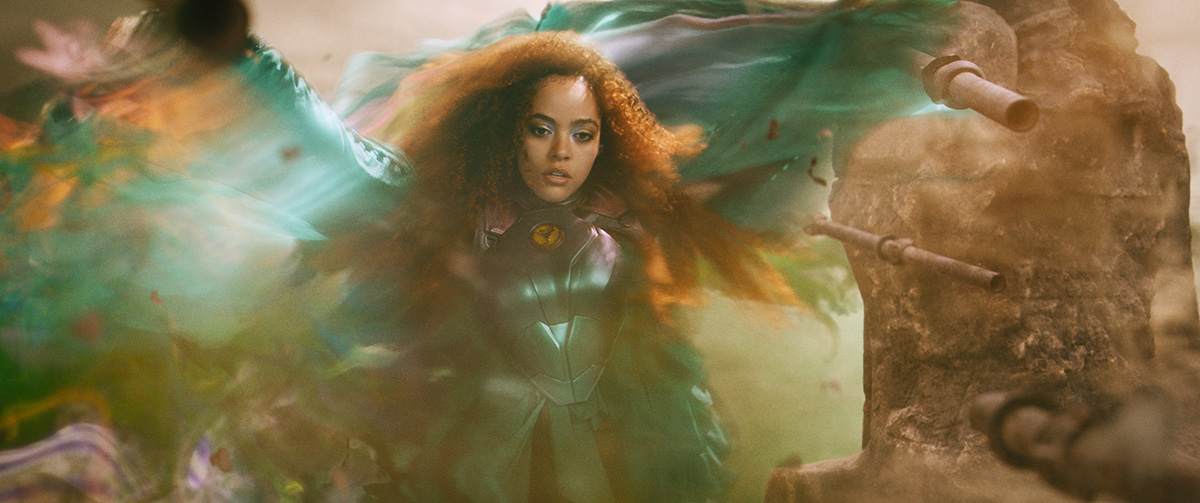 QUINTESSA SWINDELL as Cyclone in New Line Cinema’s action adventure “BLACK ADAM,” a Warner Bros. Pictures release.
QUINTESSA SWINDELL as Cyclone in New Line Cinema’s action adventure “BLACK ADAM,” a Warner Bros. Pictures release.
Mike was talking about trying to keep the length and exposition of reel 1 to a minimum. Tell me a little bit about the set up of the JSA. Was that longer at the beginning? In the script was there more set-up or backstory to them?
LEE: There was a lot of different scenes shot and we tried a lot of different things. Everything was great. They were all fantastic. But — once again — it works on paper, but then when you look at it we're kind of having a detour that's going for too long before we get back to Black Adam who’s just woken up from 5000 years. You just want to see what he's doing next, and so you can't be away for too long from Black Adam. We ended up having to whittle it down to just have the the bare minimum, because there are all sorts of back stories with Hawkman.
I cut the whole movie, and then when Mike came on, he started at the beginning and re-edited the first three reels. And I'd be doing reels four, five and six. And then the next time around. We'd say, “Why don't you do four, five and six and I'll do one, two and three.” We did that for a while, and it was actually fun because with two editors you always find things that you hadn't thought of and you feel like an idiot. Mike would show me something and I'd say, “Oh! I can't believe I didn’t do that.” So we would give the reels back and forth.
John, you mentioned that when you started cutting, you were a little bit more conservative and you also didn't use music and the director said, “Hey, I don't want it conservative and I want it with music.” One of my early issues when I started cutting narrative was those things would drive me crazy. I would feel so bad that I didn't do it that way. But it's not an indictment of you, right? It's just a different way that somebody wants to see it. It's not anything that you did wrong. You have to think of it as, “Okay, let's do it that way.”
LEE: Sometimes I did something wrong. But there were cameras just put in that were shooting from the top or from the bottom or from across the line, for example, where I'd think, oh, well, I can't use that because we'd be cutting across the line. So I'm going to just ignore that for a while, because I'm thinking, “Well, these are all options.” And then I found with Jaume, they're not options. Use them. Sitting in a room with him, he'd say, “Okay, now cut to the top shot.” And I’d think, “Wow, that's weird to cut to that there.” But you do it and it works. Stylish. He has a certain style, I learned a lot from him.
Actually, there was a moment where we were recutting some of the scenes that I did, and I could see, “Oh, I see what he's about now.” After that I actually went and I redid the other scenes to put it more in his style because I knew there were these angles and I had thought, “Well, I can't really fit that in.” But sometimes he would want that angle and we’d just cut to it.
Sometimes a director's note on one scene helps you with other scenes.
LEE: Yeah, for sure. I think he went in with Mike for a little while and I just went through and redid a bunch of my scenes. It does involve using all those angles. You can really tighten it as well.
That's interesting.
LEE: That was part of it: to keep the pace going.
I noticed the flashbacks. Everybody's got a different attitude towards them. They were basically cut straight. No real sound design to let you know you're in a flashback. Was that a thought that you guys had? What are we going to do?
SALE: We had a lot of different transitions and ways in and out of those things that we tried. By the way, with how we unfolded that story and moved that around, I think I probably made 100 versions of the movie, no joke. Moving where we tell that story, how we tell that story when we go to flashback. Some were designed, some of them were not. A lot of that was done editorially. How to sort of unfold Black Adam’s back story to give it the most emotionality, right? And it's very, very different from where we started — like very.
In terms of the transitions, the color timing is different. But our main thing is we feel like people know when they’re in the flashback. We go through his eyes so we just didn't feel like we needed a big gimmicky effect in there because every time we did that kind of thing, it just seemed to step on the emotion of where we were in the movie. Even late in the game, John and I probably had more audible transitions in there, I bet. But as we sort of started to get more music and the sound effects started coming in, it's a big loud action movie, so in those moments we thought, “Let's just let it kind of be quiet and we are going to trust the audience knows what’s a flashback.”
If you have a lot of flashbacks, then it's going to get annoying if you have, you know, a whoosh every time.
SALE: A lot of the back story originally was told at the beginning of reel 2, which is while we're meeting the Justice Society. And it was awesome. The visuals were similar to what we have and looked awesome, but it was very long there and it didn't involve Black Adam in the story. It was kind of expositional and non-emotional.
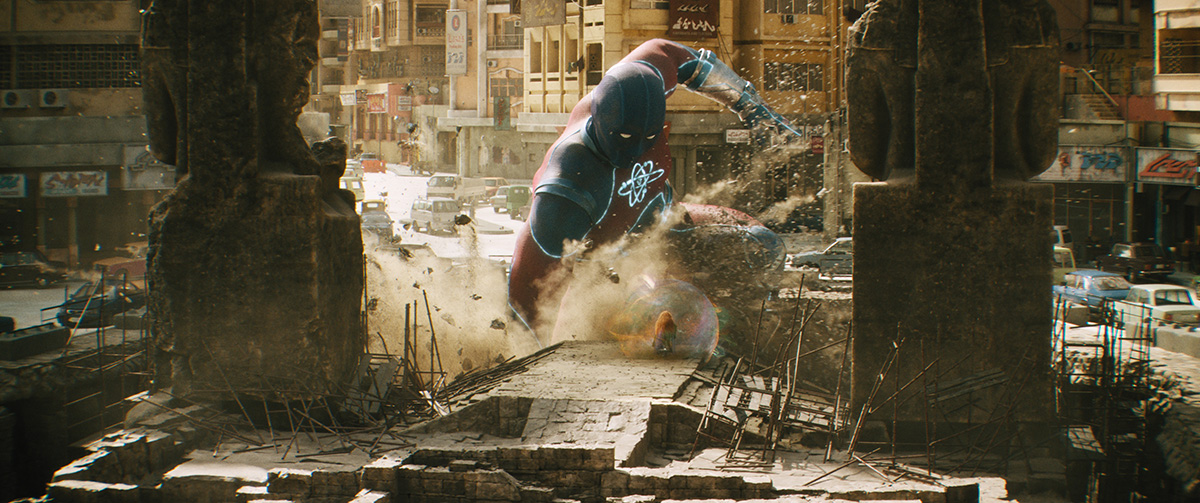 NOAH CENTINEO as Atom Smasher in New Line Cinema’s action adventure “BLACK ADAM,” a Warner Bros. Pictures release.
NOAH CENTINEO as Atom Smasher in New Line Cinema’s action adventure “BLACK ADAM,” a Warner Bros. Pictures release.
Very interesting.
SALE: So putting that into his words and trying to put it through his character was a mission that we had from pretty early on. That's a hard thing to change. That's a lot of trial and error to try to get that to work.
It was something that Jaume was interested in. We always had this sort of slow down after he comes out of the Rock of Eternity and after he's in the desert. We had this sort of big slow down going on, some of which was addressed by trimming some of the JSA stuff.
There wasn't a scene of Smasher trying on the suit for the first time and discovering he could get big. There was no origin stuff. There was more scene to it, but it didn't really give you the back story that maybe some people want. Again, it was a movie that was very stuffed with a lot of stuff, so we had to pick and choose the lanes.
So as opposed to making a movie that maybe some people would have liked more — where maybe it would be 45 minutes longer, where we spend a lot of time developing each one of these characters — and that certainly could have been a film that somebody made. I probably would have liked that one. Not that I don't like this.
Instead of doing that — because you don't want to be away from Dwayne for too long — our goal was let's make a movie where you get introduced to the JSA and by the end of the movie, you WANT that story. I would say mission accomplished. When people leave the movie they want to know more about Hawkman. What is going on with this Smasher and Cyclone? So that was sort of the lane we picked.
With the flashbacks, the lane was, “Let's tell this through Black Adam's eyes.” And it's an intimate story about his son and their relationship. We want families to enjoy this movie, so the quest was: can we make you feel something when he's telling that story? So that was a long, long time to get that to work in a different way.
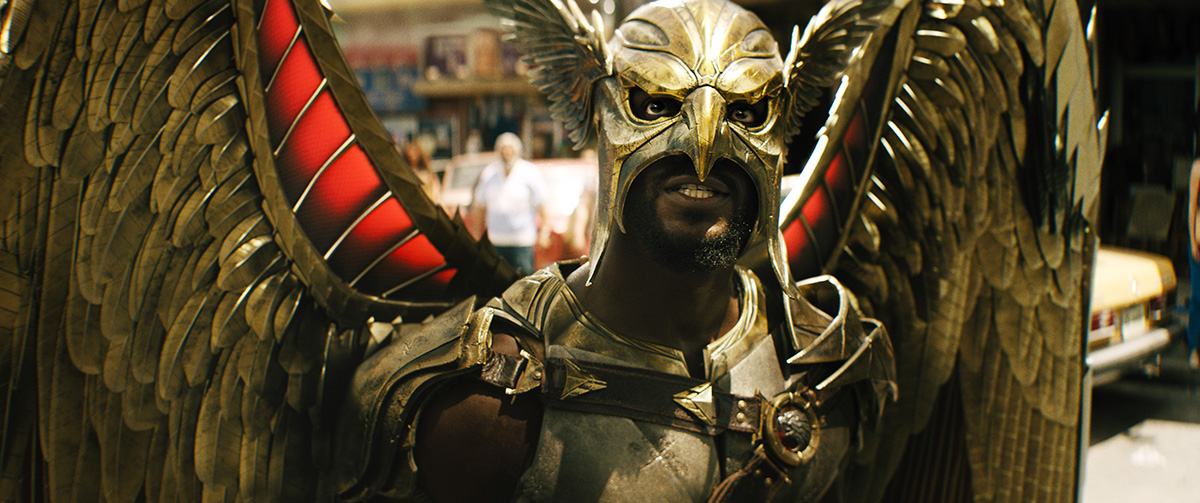 ALDIS HODGE as Hawkman in New Line Cinema’s action adventure “BLACK ADAM,” a Warner Bros. Pictures release.
ALDIS HODGE as Hawkman in New Line Cinema’s action adventure “BLACK ADAM,” a Warner Bros. Pictures release.
I've heard from a bunch of people that they say when you do those audience screenings, a lot of the people that are in the audience, they're trying to make a different movie than you, right?
LEE: Whenever I do a film like this, I always read the graphic novels. It kind of helps me a little bit, but you have to also realize they're not shooting that. There's always someone in the audience that you can tell they've read the whole thing and they're like, “Well, why didn't this happen?” And it's because we can't fit everything in the comic books, which have been around since 1945 into this one movie.
SALE: Audiences — when they give you notes and thoughts — as with other people too, the problem that they find or the thing they don't like or the thing they're talking about is usually real. And it's good to listen to the fans and listen to that feedback. But the solutions that people come up with are usually not a good idea or are not practical. So it's listening to the fans — which we like to do — but then trying to solve the problem in a way that elevates the movie.
LEE: You never discount anything that anyone says because like Mike says, it's always valid. Studio executives as well, when they see the film, they'll have notes and they're always valid, but maybe their solution isn't the solution. Maybe there's another solution.
SALE: It's good when it is!
LEE: Yeah! You can just do it! And then we can tell them, “We did your note. It’s brilliant.”
There is a tricky little section — at least I would think so editorially — where Black Adam has watched a gunfight on TV and then later on there's a reprise of that gunfight and it was shot very similar to the gunfight, but it had to be in the middle of a Black Adam fight. So can you talk to me about trying to get in and out of that, tonewise?
LEE: There were a lot of different versions of that scene. Krisztian had done a version where it was over very quickly and it was also funny that way, but then you missed the Western kind of thing. It's like you're setting up for a Western and then Black Adam just kills everyone. But, the Western thing really worked, and I think Mike went back and re-edited what we saw of the Western on the TV?
SALE: We had many versions of the actual gunfight. It's The Good, the Bad, and the Ugly.
Being that I started back in the Naked Gun days of comedy, parodying has a certain way you have to do it. Mainly you want to be true to the actual material as much as you can. There were several versions when I got there. They had a crazy long one that was shot.
I don't know if you remember the scene in The Good, The Bad, and the Ugly, but it's like seven and a half minutes long. There was something delightful about the crazy long version.
If you're an older person — when I hear that music — you know it’s The Good, the Bad and the Ugly. When younger people hear that music, they're like, “What the hell is this? Why is there this music playing?” So there was a challenge. One thing we talk about always is the setup or teaching the audience. It's difficult to sort of change tones like that in the middle of the movie because that's a little parody. But the trick was we added a lot to the TV of the setup so that it could pay off later.
We added a whole beat there. There’s a little bit of a pregnant pause right after Black Adam comes out of the wall. It was mainly to get the shot of the hand. That was a real recognizable similar shot. It is one of the sillier moments and we were always wondering, “How are we going to get away with this?”
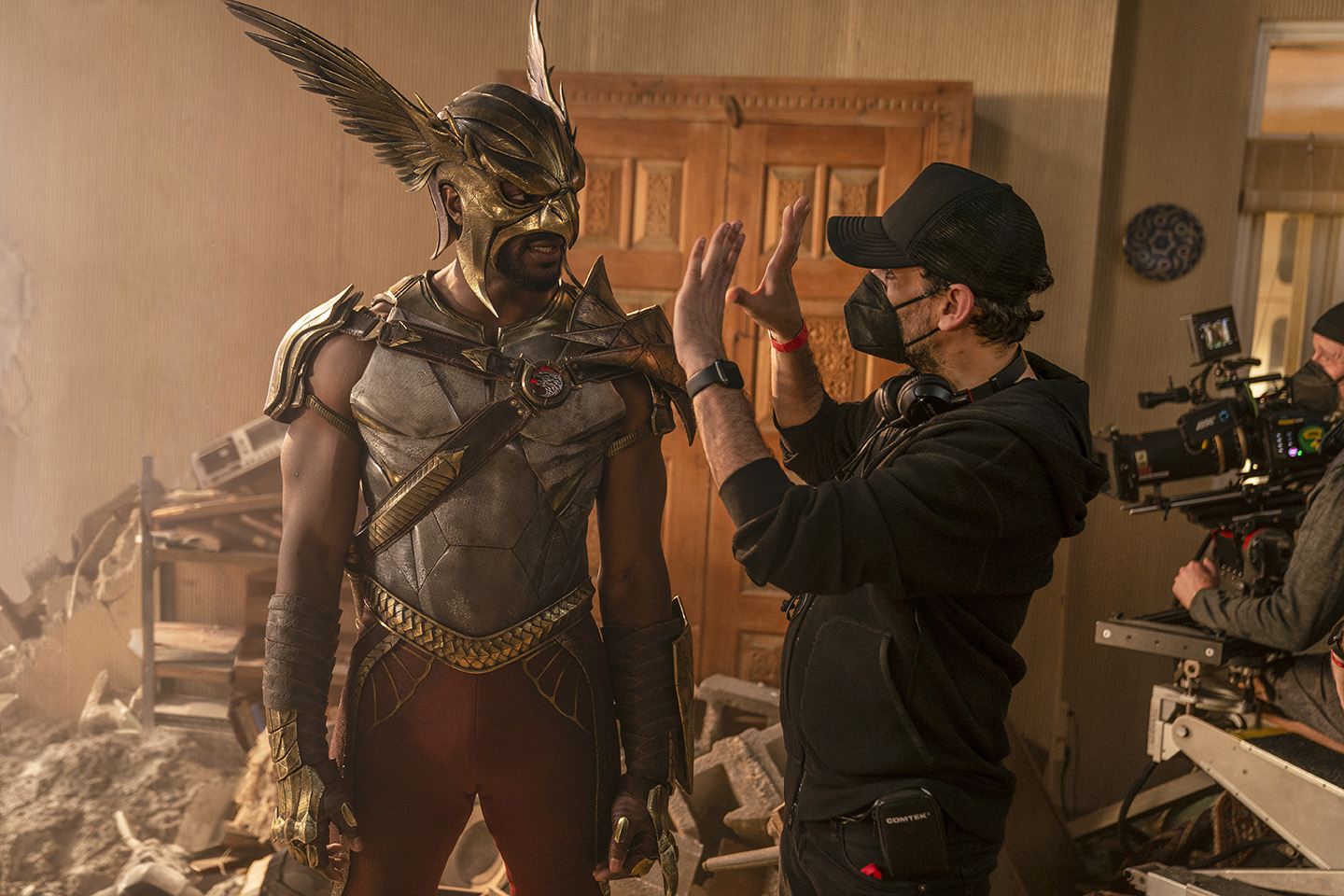 (L-R) ALDIS HODGE and Director JAUME COLLET-SERRA on the set of New Line Cinema’s action adventure “BLACK ADAM,” a Warner Bros. Pictures release.
(L-R) ALDIS HODGE and Director JAUME COLLET-SERRA on the set of New Line Cinema’s action adventure “BLACK ADAM,” a Warner Bros. Pictures release.
I loved it. There was even the Sergio Leone movie music in there, right?
SALE: Yeah. You’ve got to have the music. Editing that stuff was interesting because they don't want people to make weird stuff out of their movie. A lot of people like to use that footage. So there was a set of rules to protect their property. You couldn't juggle it around. You could compress time, but the order had to be correct in those clips in the TV.
Very interesting.
LEE: So you couldn't re-edit the pictures that were on the TV. If you cut to the TV, it had be in sequence. I had a version where I’d chopped it up and you can't do that. So we had to find the bits that were complete and go from there.
SALE: We tested a version where it actually works a little better, but it involved moving those shots around, so we had to put it back.
LEE: Also, we can't have anyone with a cigarette, but Clint’s always got that cheroot (filterless hand-rolled cigarette) in his mouth. We had to be careful about those kind of things.
Oh my gosh. That's a lot to juggle.
Talk to me about how you were able to deal with pacing when so much of the movie is visual effects. Was it previs stuff or were you trying to comp stuff? How can you edit when you have so little actual finished footage?
LEE: We had additional photography about a year later. They shoot enough to make the movie, but they know that they're going to come back and shoot some extra stuff. So there was a moment where we had a lot of storyboard artists and we would ask them to draw things for us or we would do still frames or we would get things from other movies. Krisztian was always doing that. He'd say, “Oh, I've got this shot from Star Wars” or whatever, and throw it in and we put a title on it saying, “Like this but different.”
So there's a point where we're getting ready to do this additional photography where we're thinking, “What do we need?” So we're drawing what we need or stealing from other movies or cobbling it together somehow. And then it's a matter of just editing it with timing, really. You just imagine, “Oh, we're going to cut to that and it's going to be on the frame for one, two, three. Okay, done.” And so you kind of cut it like that. And then they go and they shoot all of that stuff and then it all kind of works.
SALE: Like in a comedy, you can kind of get the pace right — very close — during the director's cut. And then you're dialing up humor, dialing it down, making sure there's no confusions and stuff. But you can get the rhythm of a pace of movie very quickly, if it's a comedy that doesn't have tons of visual effects.
On a visual effects movie like this, it's hard for several reasons. One is: if you give up a shot that is VFX? It's gone, man. You can't cut it back in. It comes out of the budget. It's not on VFX anymore. They're not going to pay for it. The company isn't working on it. So cutting out a shot — the risk, the stakes — become much higher. You can trim things and stuff, but essentially what happens is you carry a lot of stuff a lot longer into the process than you would on a traditional film.
Very interesting.
SALE: Then near the end of cutting the movie, I call it “The Lightning Round,” because basically what happens is as you hit the last ten weeks of making one of these movies, you’re getting shots 24/7 and then you're sort of re-editing with the shots that they gave you. Sometimes it's even more horrifying than trimming: it's ADDING frames, which at that point in the movie, you've got the composer trying to do final score, you've got the people on the mix stage, and you're saying, “No, I gotta add six frames.” Or you just see something cool in the visual effect that you didn't realize how good it was going to be, so you think, “Well, we got to use all of that,” right? So in terms of pace, John and I were relentless from, I would say, October till beyond the very last day of working on this movie.
Which was when?
SALE: We were done with this movie in September 2022, right? So it was almost ten months and we were constantly pushing and driving, making stuff ahead of time that had trims. So we're like, “Well, if this shot's here, we've got this version. It's tighter,” presenting those to Jaume like backup plan after backup plan after backup plan so that we could retrofit this stuff. And both of us were at it.
John would go through reel 1 and he'd pull out 3 minutes maybe, and I would look at it and say, “I miss A, B and C,” Or we think that the directors and the producers will miss A, B and C. Is there a way to do this? I would go through and make a version, but John would say, “Oh, but now this doesn't work,” and this went on, Steve, for months and months. We watched the movie basically every Saturday, and we had all different versions. We had versions that were probably 15 minutes shorter than what you're seeing now. Not that they were better. It was just, “How far can we push the material? How much needs to stay in? Is this wise? Is this good?”
And there were certain places where we probably would have bet the farm that they weren't going to be in the final movie. But Bill Westenhofer — the visual effects supervisor — he made some stuff that when we got it back, we thought, “Glad we hung around and left it in!” Giant things that we would have thought, “You're not going to need this. People only care about Black Adam.” And to the director's credit, Jaume, who is really a visionary, he fought like a badger to keep things in. He made it difficult to just cut stuff out. Nothing was thoughtless on this movie.
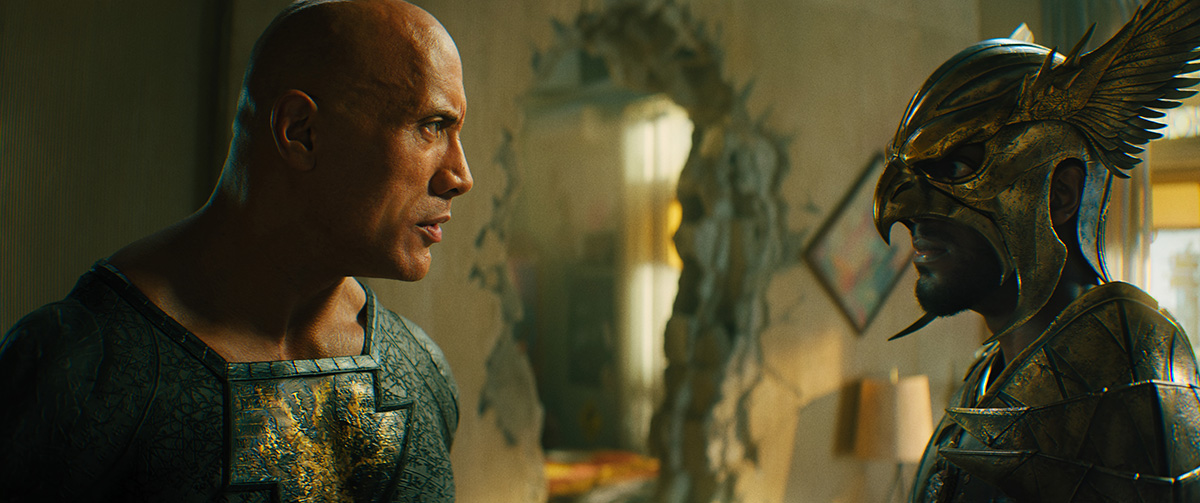 (L-R) DWAYNE JOHNSON as Black Adam and ALDIS HODGE as Hawkman in New Line Cinema’s action adventure “BLACK ADAM,” a Warner Bros. Pictures release.
(L-R) DWAYNE JOHNSON as Black Adam and ALDIS HODGE as Hawkman in New Line Cinema’s action adventure “BLACK ADAM,” a Warner Bros. Pictures release.
Talk to me about the scene closer to the end of the movie where Hawkman and Black Adam fight in the apartment. And there are a lot of transitions between slo mo and regular speed. Can you talk to me what tells you “I want to be in normal speed. I want to be faster than normal. I want to be slower than normal?”
LEE: A lot of that scene where they're fighting in the kid's bedroom was about destroying the other DC properties. He had a lot of tchotchkes on the shelf. He had Batman and Wonder Woman posters. So a lot of it was about destroying those in a way. So we needed to see those moments. Batman falls onto the skateboard. It was absurd to have two grown men fighting in a tiny little bedroom and one guy's got these huge wings and whenever he turns around, he knocks things over and there's marbles flying everywhere and skateboards breaking.
That scene also took a long time and we all took many turns at it. To just hit those particular funny moments. Like, let's have the Batman statue land on the skateboard. So that was a slow motion moment. But then you want this frantic fight as well, so those have to be fast. We spent a lot of time making these characters equal. You don't want Black Adam to be so powerful that with one punch Hawkman would be out of the picture. So you wanted them to be able to have a fight where you think, “Oh my goodness, Hawkman could win this.”
SALE: In this movie you have characters that can go faster than normal, like lightning fast. So Black Adam can zip around and Doctor Fate can magically reappear in one area.
So if you think of that scene in two sections: one is in the apartment when they first start fighting before they go into Amon’s room. The motion effects in there are basically showing the speed that they can fly around and so there's not a lot of slo mo in there. You're kind of seeing what it might look like if somebody can move that fast.
Then to break up the scene and also to make it feel special — as John was saying — once you go into Amon’s room, the slo mo is really used as an effect to highlight the things that are happening too fast to see. In the real life, if you had shot what happened inside the boy's room, it's only like 4 seconds long. So the slo mo in the room allows to get the effect of the comedy and the moments that you want to highlight for the audience to see.
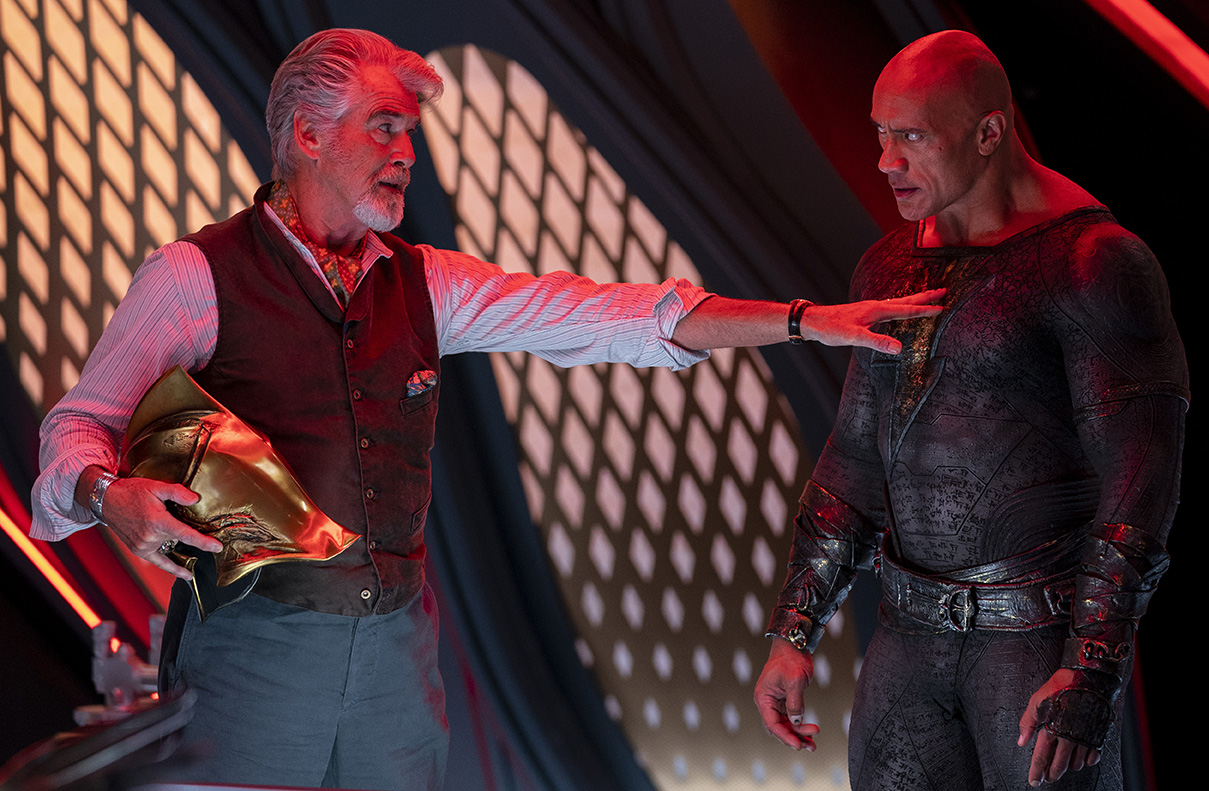 Caption: (L-R) PIERCE BROSNAN as Dr. Fate and DWAYNE JOHNSON as Black Adam in New Line Cinema’s action adventure “BLACK ADAM,” a Warner Bros. Pictures release.
Caption: (L-R) PIERCE BROSNAN as Dr. Fate and DWAYNE JOHNSON as Black Adam in New Line Cinema’s action adventure “BLACK ADAM,” a Warner Bros. Pictures release.
The slow-mo shots are the punch lines.
SALE: Exactly.
LEE: Yeah.
Michael mentioned how you changed some of the intercutting between the flashbacks and everything else. What about the intercutting between the JSA and the Black Adam story? Because for quite a while in the middle, they’re separate. JSA is looking for Black Adam. Was that ever juggled: the intercutting between those two storylines?
LEE: Oh yes. There was a moment where I was working with Jaume and Mike did this great thing where he just sat in his room and kind of went crazy and he would call me in and say, “Look what I've done!” And it would be, “Let's intercut everything!” Then we would show Jaume, and he would like some of it or he would say, “No, I don't want to do that.” But there were a few weeks there where Mike was just coming up with different things, which was fun.
That's a good thing about having two editors is that I was just in with Jaume for weeks doing whatever, and Mike was just getting up to speed, but more or less having fun with it, I would say.
SALE: Jaume said, “Go rogue,” not “Go crazy.”
That was your assignment? To “Go rogue” on the material?
SALE: Literally, that was my assignment.
One of the things that I think can affect filmmaking is — especially when you're doing the visual effects and it's coming out of a previs world where everything's so heavily storyboarded — then prevised is you can get this stasis where the movie just isn't evolving. Because in a lot of people's minds it already exists. It's right there. I can see it.
So, Jaume is super-smart and very savvy and very good at using the talent he has assembled. He was great at giving John assignments and giving me stuff. Once I got up to speed, which took a couple of months, Steve, because, again, super-complex movie and I hadn't watched a lot of the dailies, so I didn’t have the same intimacy with the material. It's not even watching the dailies. It's cutting them where you really start to memorize the stuff. He looked at all my experience and said, “Listen, go in there and don't just trim a few frames. Go in there and make different versions, make different patterns. And he called it ‘Going Rogue.’”
The freedom to do that was incredible. Then I would pass it to John and we loop things around together all the time. John and I stayed as a team for the entire time. Like there was never a ‘battling of the bands.’ Even if I was doing a rogue version in another room, I was showing it to John every night and he was showing me what they were doing. So we were trying to look at the end game and how can we get there all together.
And part of that was we knew that they were going to go back and finish shooting. John is right, “reshoots” is a terrible word for that. It was remaining photography. And they did it because Jaume is smart he knew, “Once we start working this material, we're going to find out that there's story elements that we couldn't have predicted when we were doing the first shoot.”
So by doing many, many versions and trying and experimenting, we found a lot of cool things. With the JSA, they were originally not in the ship flying to Black Adam. They were sitting in the mansion talking. And one thing we discovered is when the action scene of Black Adam waking up in the Rock of Eternity and killing the army was so huge and intense. It was really weird to have the movie kind of just stop moving and have people sitting and talking.
If you look at the introduction of the JSA, you'll see that everything's moving in those scenes and they're on this ship pretty quick and they never stopped moving towards him. So basically that intercut is two things moving towards each other all the way until they find him.
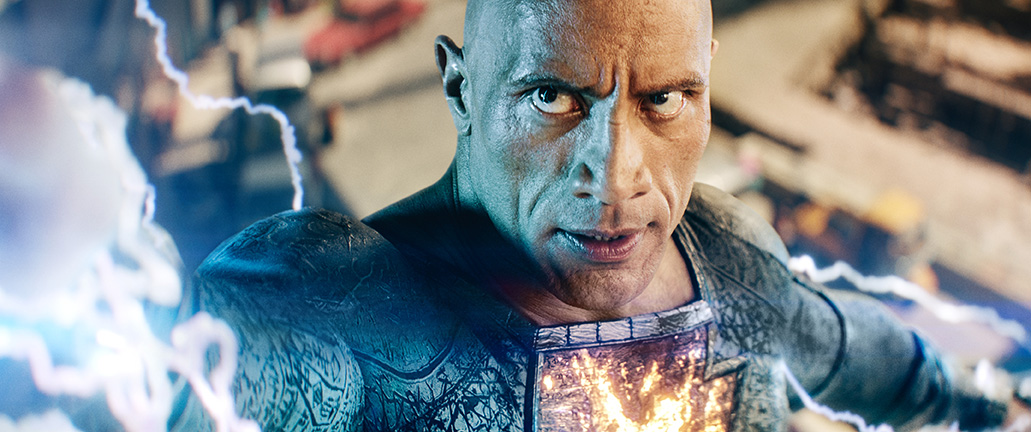 DWAYNE JOHNSON as Black Adam in New Line Cinema’s action adventure “BLACK ADAM,” a Warner Bros. Pictures release.
DWAYNE JOHNSON as Black Adam in New Line Cinema’s action adventure “BLACK ADAM,” a Warner Bros. Pictures release.
So you did “go rogue” and not all your ideas got used, I'm assuming so talk about the value of an idea that doesn't get used.
SALE: I think it's super important to try many, many different things. And if you're working with filmmakers who give you the creative space to fail — which is a very important thing. If you're not worried about being humiliated or chastised in some way for trying something that might be outrageous or might be very different from what the original plan is, what it allows you to do is try a lot of stuff and you might fail quite a bit.
There were sometimes where I thought I’d made something really good. And then John, I would sit down on a Saturday and we had a nice little theater at the office and we'd watch it and then the lights would come up and we'd be like, “That didn't work.”
LEE: Or we’d say, “Well, that works great up until reel 4, and then it fell over completely. Unrecoverable.” So we're sitting there like kids with our popcorn and we're saying, “Oh, this is great! This is great! We've cracked it! …. Oh, no! It's terrible!”
SALE: So the value in being allowed to try things, Steve, is I think what you get is you can get to a level where things work much better than they could have worked if you were just taking the safe route.
Even if I'm working with people who might not be as generous with that creative space to fail as someone like Jaume, I still do it. Even when it's hard to do. I do it because pushing the material lets you find the limitations. And I feel like at the end of the day you go home and say, “Okay, no stone has been left unturned and we have tried every version of this and we have discovered some things.” And inevitably we did discover some great things that ended up in the film. But yes, you have to be willing to fail. And there is a lot of failure to get to that. And it can be very frustrating.
Tell me about score. It seems like there was a lot of score. What did you temp with and was there a place where you felt like, “What we need is silence here?”
LEE: Jaume had some really crazy things in the temp and some of them took a long time to get out because when people see a film and it's working, they think, “Oh no! Let's not change THAT track.” But there's something about it that doesn't work and so we would always be trying different things and throwing them in there, or — like that opening scene — we would cut it with different tracks. “Let's try a rap track. Let's try heavy metal. Let's just shake it up.”
And when (composer) Lorne (Balfe) came on, he just seemed to be so quick! We had temps from all over the place in there and then suddenly it became cohesive because all of those different characters need a theme. So you can’t temp with the score from Wonder Woman, because everyone knows the Wonder Woman theme and everything, and it's for her. It's not for these characters.
When Lorne came along suddenly it opened the whole thing up. Black Adam has a theme. Cyclone has a theme. And then it was a matter of “Where can we get some fun needle drops in?” That track Kareem is listening to in the van, we’re just going old school with that.
Lorne was the key for that and he wrote a lot of music. There were moments where we thought, “Let's take a break somewhere.” Jaume would talk to Lorne and they would figure that out.
SALE: First of all, temp scoring an anti-hero comic book character: there aren't a lot of them. So, threading that needle of music that sounds heroic, but yet is dark, there's not a massive library to draw upon of music like that. So the temp stuff was really challenging on this film.
That’s why when Lorne came it was almost like we were refreshed once we started to hear his music come in and allowed us to actually to continue just to elevate the film.
It was hard to find places to have silence. And we were looking all the way through the final mix. We tried probably a dozen more places where we pulled out music to try to create that space. But ultimately it just didn't seem to work. The movie's doing a lot of stuff and you have all these characters and you need to kind of go with them. So that music is a big, big part of feeling Cyclone's heroism or any of those things.
Yeah, it's a big spectacle movie.
SALE: It's a big spectacle, so it's hard. When you're sitting in a room for 12, 14 hours a day, whether you're in your picture cutting room or on a mixing stage and you're working on that. I mean, it is just assaulting the senses. You have to be really careful to, like, keep it low for a lot of the day and like not overdo it.
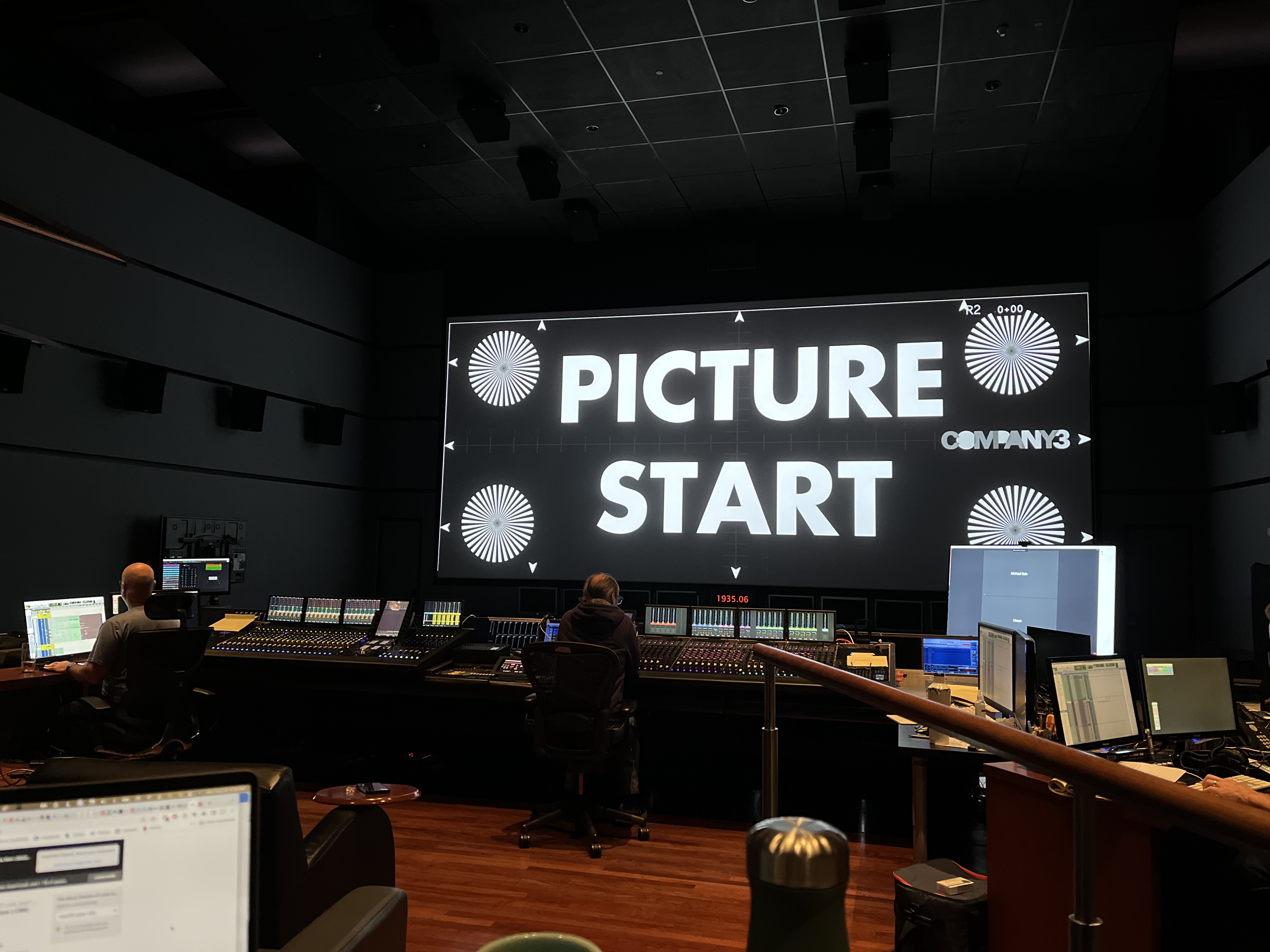 Mix stage on Black Adam
Mix stage on Black Adam
What's the value of having the editors in the mix?
LEE: When we were on the mic stage, we were cutting in visual effects up until the last minute. So we always have an Avid on the stage and it drives the sound people crazy, but we change things. We have to. The visual effects come in and we have to change it a little.
We’re very involved with the sound. We would have Bill Dean, our sound designer give us things back and we put them in the Avid all the time so that we could play them Jaume. Like, what does Cyclone sound like or what's a fly bike sound like. So then when we go to the mix, it's just continuing that process, because we're so in tune with what things should be.
And we can do a pass before Jaume shows up, because you don't want to waste the director's time. So Mike and I would be on the mix stage and we'd get it the way that we liked it, and then we'd have Jaume come in and he would have hopefully not many notes because we know how he thinks and we know what we're doing by then.
Then he would come in and he would have his notes. And they were always very perfect kind of notes. And we would go and do those, and then we'd show him again. So it was very important that we were there, I think.
SALE: If you think about it, Steve, we've been mixing the movie for a year with Jaume on the Avid. So we basically know what he likes. So then we go there and we communicate with the sound editors. We've also been working with music editors. We've been working with visual effects. We're kind of in the center of all these people where we've been giving and receiving for a long time.
And so it's essential to have the editors at the mix so that we can get the mix to a place where it plays and everything works and we know the beats and things as Jaume might want them. And then instead of him coming in trying to get everything together, he's coming in and he can elevate and play with and push and try stuff. And it makes for a mix where you're not just getting it to happen, you're actually elevating it and being creative.
LEE: And once again, having two of us was perfect because sometimes there was so much going on, especially earlier for the temp mixes and stuff. There was a lot of cutting still going on. So we would trade off. I would go to the mix one day and then Mike would go another day. We could split up the duties and it was very helpful.
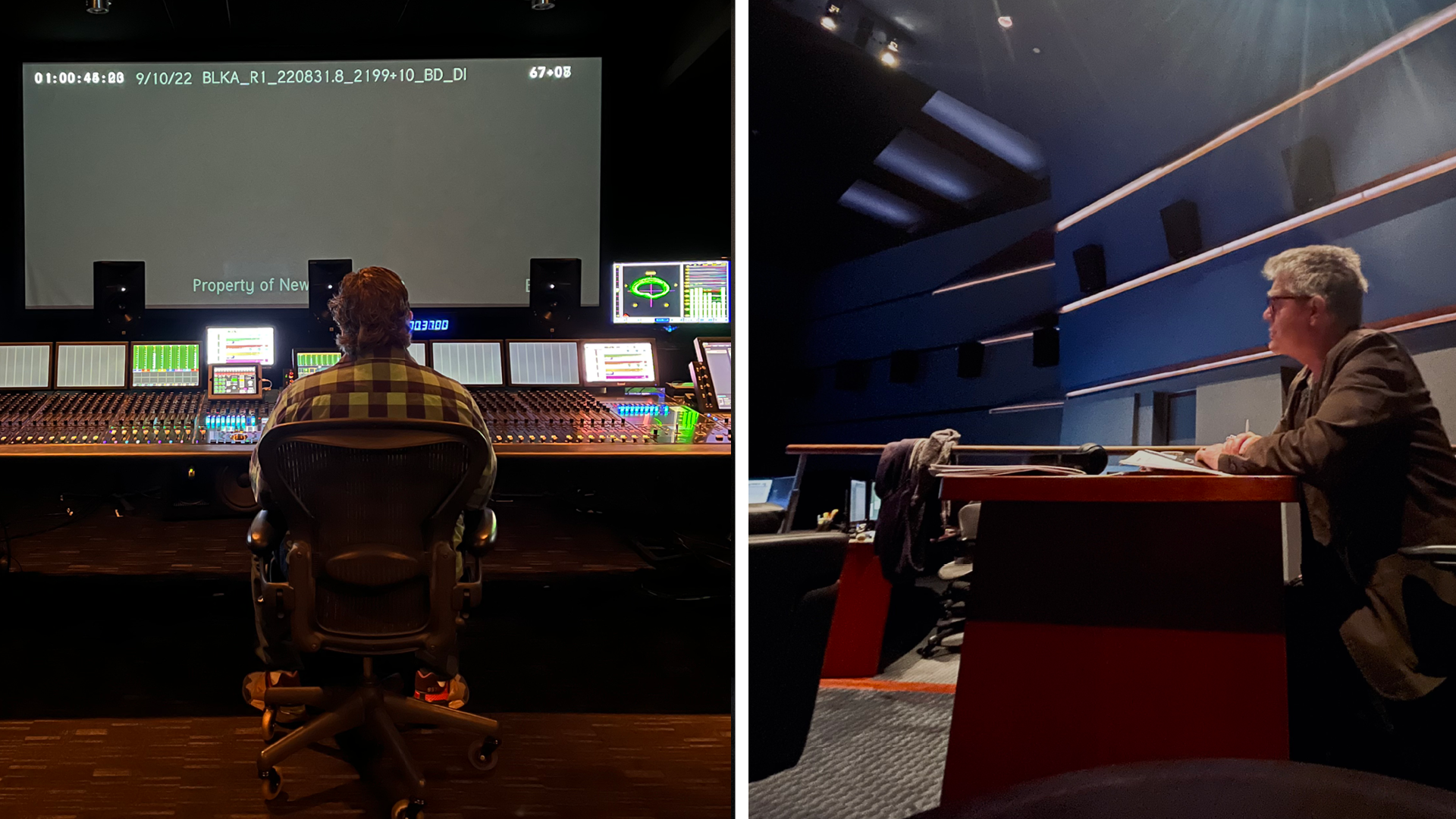 (L-R) Editor Mike Sale checking near field mix, editor John Lee at the mix stage
(L-R) Editor Mike Sale checking near field mix, editor John Lee at the mix stage
I was thinking of your earlier analogy of how much stuff got taken care of in the previs and there were all kinds of decisions that were made in the previs that once Krisztian told you guys about it, you would say, “Oh, now I understand.”
It's the same thing going in the mix. You guys have been party to all these discussions of what's important, what's a story point, and then you can convey that to the mixers: “We need that sound effect. No. It's got to be this particular tone. We've got to be able to hear that guy in the background say this.”
LEE: Yeah, exactly. And Jaume had an interesting thing about the sound. When I first came on, I thought, “We’ve got to really nail down what these different creatures sound like and everything.” But Jaume turned it around and said, “No. The first thing I want to do is I want the WORLD to sound perfect.” So he had the sound guys, make sure that ancient Khandaq sounded a certain way. Modern Khandaq — with all the traffic and everything — sounded a certain way so that the whole film was rooted in this reality. And so that was interesting as well.
All right. Well, gentlemen, I really appreciate both of you guys joining us and talking to us about Black Adam.
SALE: Thanks, Steve.
LEE: Thank you so much. It was fun.
